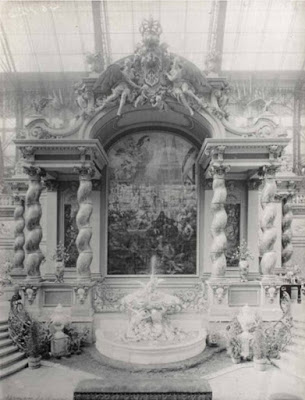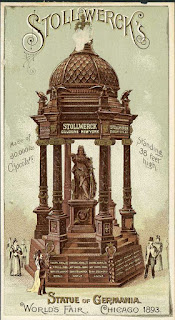Germania, the mythological embodiment of unified Germany, made many appearances around the Fair. You can spot her among the throng of ladies embodying Ideas because she’s the one with a big sword. She often has the Imperial eagle all over her armor and clothes and the Imperial crown in one hand or on her head.
A number of companies cashed in on the Germania craze, like Chicago's Germania Stomach Bitters. My favorite advertising version was a temple in the Agriculture Building that was 38 feet high and made of 30,000 pounds of chocolate. Germania herself was sculpted out of a solid block of 2,200 pounds of chocolate. Exhibitors needed a gimmick to attract an audience in the teeming chaos of the main buildings, and Germania was Stollwerck’s. It competed for attention with the French Maillard Brothers’ chocolate Venus de Milo. The chocolate was coated with an edible varnish in hopes it wouldn’t melt in the un-air-conditioned Chicago summer. The French Venus apparently sagged in the heat but as far as I can tell Germania did not, a triumph for the Fatherland. More damage was done by unauthorized nibbling than the heat. Companies couldn’t sell in the 14 themed buildings, but they could hand out trade cards, so chocolate Germania does survive on E-Bay.
One Germania at the Fair made a spectacular temporary appearance on the evening of June 16 to wrap up German Day as a pyrotechnic display in the Court of Honor illuminated a Germania as tall as the original Golden Lady next to her. It included writhing silver snakes and golden spitting dragons exploding in the air and water and a concert of "Wacht am Rhein."
A Germania who survived for a time reigned over the immense German pavilion in the Manufacturing and Liberal Arts Building. She towered just under the rafters. She was loaned by Kaiser Wilhelm while her permanent spot on the Reichstag was being prepared. It took four days to get her and her four horses onto her perch. I doubt she survived the Reichstag fire, but I haven’t confirmed her later fate.
A homeless Germania from the same exhibit has survived. The "Glory of Germania" is a tribute to German Culture with portraits of Goethe, Mozart, Martin Luther, Guttenberg, and others. It’s an 18 by 12 foot work of 1,057 porcelain tiles. In it Germania inspires great Germans in front of the spires of the recently completed Cologne cathedral. Father Rhine at the bottom seems a bit more suitable for the wine exhibit in the Horticulture Building or the beer sampling in the Agriculture Building than the high minded Liberal Arts.
 |
| From Dank Haus: https://dankhaus.com/event-3823873 |
It appeared in an immense “altar” that some wags called the Porcelain Porch.
 |
| Image from the Ryerson & Burnham Archive Archival Image Collection at the Art Institute of Chicago, RBA Digital File name M525888.jpg. |
When the Fair was over, Kaiser Wilhelm II donated the Glory of Germania to the Germania Club of Chicago for their Grand Ballroom. The club and the German-American community were a political force in the city, but by 1986, their influence had waned, the club’s building was sold, and the art collection, including the tiles were taken down. In 2018, the DANK HAUS German American Cultural Center reassembled the tiles on the floor for an exhibit (which is why the photo has an odd angle and reflects ceiling lights). So, the Glory of Germania survives but needs a large new home.
There’s another Germania who probably survives in pieces and indeed it’s only because of the pieces that I realized she existed at all. I’ve had a hard time trying to find her during the fair but found a clue on a high-resolution map. I think she was in the area labeled Outside Exhibit of Germany in the hodge podge south of the Court of Honor. She must have been guarding the German horses and cows that were on show in the barns behind her. To orient people familiar with the current park, the Administration Building, circled in gold on the map, is west of where the Statue of the Republic replica is now.
Unlike nearly everything else at the Fair, she was made of concrete. When the Fair was over, she was left standing in the grass until, as near as I can tell, 1905. She was in the way of the golf course, so, they smashed her up, used her for land fill, and forgot about her. In 2003, workers were startled to find recognizable chunks of a concrete woman as they were redoing Lake Shore Drive. The Park District announced the fragments would be on display in the Iowa Building, but that didn’t happen, and she has once more disappeared from view.
 |
| https://www.periodpaper.com/products/1893-chicago-worlds-fair-statue-germania-cement-german-original-historic-image-022201-fai4-39 |


The fragments were found north of the "Animal" bridge on the Coast Guard Drive part of S. Lake Shore Drive. The bridge joins the Outer Harbor (pictured on Trish's map east-southeast of the location of the Administration Building and later Golden Lady. The Inner Harbor and the bridge did not then exist. The fragments were discovered during repair and slight realignment of the bridge for the rebuild of the Drive, completed 2004. I also have lost track of where the fragments are-- CPD Dept of Planning and Construction would know. Gary Ossewaarde
ReplyDelete